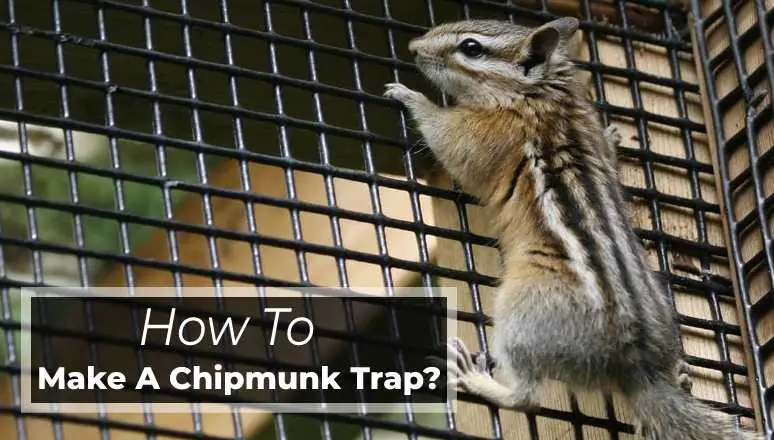3 Easy Steps On How To Make A Chipmunk Trap Live
Chipmunks may have a lovable appearance, but they can be a major headache for homeowners. It is not simple to catch chipmunks. So, how to make a chipmunk trap?
To make a chipmunk trap, you can use a bucket trap. The bucket trap will need a bucket, cardboard, and some peanuts. Also, you can use a live trap as well.

You can use the live trap with 5 easy steps: ready the trap, snap it to the chipmunk nest, set the trigger plate, and set up the trap to catch the chipmunk.
Chipmunk trapping is a technique that few of us have mastered. To get rid of chipmunks from your yard, the right procedures are important. Let’s see, how to do that.
How To Make A Chipmunk Trap With Bucket
Setting up an animal trap is one of the most common methods for catching a chipmunk or dealing with a skunk infestation. A chipmunk-baited Havahart cage trap is an example of an animal trap that uses humane chipmunk bait.
To Get Rid of Chipmunks with the Bucket Method, you will be needing the following items.
- Large bucket
- Cardboard tube (toilet paper tubes work well for this trap)
- Table, chair, or stool
- Peanut butter and sunflower seeds
The Procedures for Making Bucket Trap
A bucket trap is one of the best solutions to catch the chipmunks.
It is easy to create your bucket traps out of household items. The chipmunk can’t get out of the trap once it’s inside. Homemade skunk traps may use the same approach.
Start by determining the location of your trap. Make a sweep of your yard and flowerbeds for signs of newly dug holes.
Put the thin stick over the top of the bucket and the paint mixing stick perpendicularly to reach halfway across the hole.
Make a way up to the stir stick by constructing a ramp out of the long plywood block. Find something that chipmunks are drawn to, such as peanut butter or birdseed. The bait should be put right at the end of the stir stick.
The chipmunk must go up the ramp and cross the stir stick, balanced above the thinner stick, for the trap to be effective.
Once the rodent passes the thin stick, the stir sticks flip and fall into the bucket. This is a typical rodent trap with a decent capture rate.
How to Make A Live Chipmunk Trap Instead of Bucket Trap: 3 Easy Steps to Set
Live traps
To get rid of chipmunks from your home or yard humanely, use a live chipmunk trap. First, select the right trap.
Make the live trap ready with bait inside it. You may use peanuts or oats. Keep the trap on your hand carefully so that it doesn’t close itself. Now, the live trap is ready to set.
Set the Trigger Plate Correctly
Whatever you choose, select bait chipmunks that cannot steal. Spread peanut butter on the plate that holds the trigger. Unpeeled peanuts are an excellent solid bait bigger than the trap’s mesh.
Make sure the trigger plate is smooth and that works correctly when the chipmunk gets into it.
Carefully Set Your Trap in the Right Place
For a chipmunk-sized trap, you may need to balance rods and door locks to get the best results.
Gently touching the trigger plate will allow you to test your trap. Small traps may be sensitive to movement, so do not disrupt them once set.
Position your bait correctly: Place the bait so that the chipmunk is forced to walk on the trigger plate.
Check Trap Often
Trapped chipmunks might get thirsty, hungry, or frightened. Check your trap periodically to avoid capturing a chipmunk for too long.
You’ve Caught a Chipmunk!
Use gentleness and low-pitched speech as you approach and interact with the trap. Make sure you do not come into direct touch with a captive chipmunk by wearing gloves. If local regulations allow it, move the chipmunk five miles away from the area.
Disinfect the trap after freeing a chipmunk to avoid disease.

Frequently Asked Questions
1. What Is The Best Bait For Chipmunks?
Chipmunks like cheese. Prune pits, unroasted peanuts, maize, sunflower seeds, cereal, grains, and popcorn also work.
2. How To Catch A Chipmunk For A Pet?
Online or in-store, you can buy little rodent traps. They are 1-door and 2-door. 1-door traps are easier and allow for better bait positioning, while 2-door traps offer a greater capture rate since animals may enter from either side.
Final Words
If you’re having problems with nuisance chipmunks, ground squirrels, or mice, knowing the how to make a chipmunk trap guide will help you.
You can build an incredible trap that works well with a few standard supplies and about 10 minutes of your time.
By the way, killing animals is not appreciated at all. That is why, a live trap could be used to catch the chipmunk and free it in a jungle, or open area far from your home.




